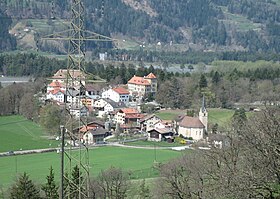Fürstenau GR
| GR is the abbreviation for the canton of Graubünden in Switzerland and is used to avoid confusion with other entries of the name Fürstenau (disambiguation) . |
| Fürstenau | |
|---|---|
| State : |
|
| Canton : |
|
| Region : | Viamala |
| BFS no. : | 3633 |
| Postal code : | 7414 |
| Coordinates : | 753 759 / 176 281 |
| Height : | 650 m above sea level M. |
| Height range : | 640–786 m above sea level M. |
| Area : | 1.32 km² |
| Residents: | 353 (December 31, 2018) |
| Population density : | 267 inhabitants per km² |
| Website: | fürstenau.ch |
|
Fürstenau |
|
| Location of the municipality | |
Fürstenau ( Rhaeto-Romanic Farschno ) is a municipality in the Viamala region of the Swiss canton of Graubünden . The community used to have town charter .
geography

Fürstenau consists of the historic town of Fürstenau and the district of Fürstenaubruck above the confluence of the Hinterrhein and Albula rivers . Fürstenau is registered in the inventory of places worth protecting in Switzerland of national importance.
history
Mairaus, the old name of Fürstenau, was first mentioned in a document in the first half of the 12th century. The new name is first recorded in 1257 with Fürstinowe . Fürst refers here to the Bishop of Chur, who owned the Meierhof von Fürstenau. The name was only later transferred to the castle that was built afterwards.
population
| Population development | ||||||||||||
|---|---|---|---|---|---|---|---|---|---|---|---|---|
| year | 1803 | 1850 | 1860 | 1888 | 1900 | 1930 | 1950 | 1980 | 1990 | 2000 | 2005 | 2016 |
| Residents | 107 | 304 | 244 | 316 | 235 | 200 | 253 | 198 | 271 | 311 | 329 | 345 |
The first wave of emigration occurred between 1850 and 1860. At that time, the population sank by 19.74% within a decade. Thereafter, the population grew continuously until 1888, when 316 residents were counted (1860–1888: + 29.51%). Two further waves of emigration between 1888 and 1900 and 1910 and 1930 caused the population to drop to a historical low of 200 people in 1930 (1888–1930: −36.71%). Then there was strong growth until 1950, followed by a last wave of emigration between 1950 and 1980. After the historic low of 1980, the population grew rapidly.
The reason for this is the beautiful landscape combined with good transport links (rail, motorway). The young people from the village stay and commute instead of leaving Fürstenau. At the same time, many “Unterländer” are moving in.
languages
Originally, the residents spoke Sutselvisch , a vernacular of the Graubünden Romansh, as a colloquial language . But the residents switched to the German language early on. While in 1880 20% of the population was Romansh as their mother tongue - and this remained so until 1900 - the proportion fell to 14% in 1910 and to 11% in 1941. Since then it has continued to decline. The community is now almost entirely German-speaking. This is also proven by the following table:
| Languages in Fürstenau GR | ||||||
| languages | 1980 census | 1990 census | 2000 census | |||
| number | proportion of | number | proportion of | number | proportion of | |
| German | 170 | 85.86% | 243 | 89.66% | 287 | 92.28% |
| Romansh | 13 | 6.57% | 15th | 5.54% | 10 | 3.22% |
| Italian | 10 | 5.05% | 4th | 1.48% | 6th | 1.93% |
| Residents | 198 | 100% | 271 | 100% | 311 | 100% |
Origin and nationality
Of the 329 residents at the end of 2005, 303 (= 92.10%) were Swiss citizens.
Attractions
The castle town of Fürstenau has remained structurally almost unchanged since the 19th century and is therefore a sight as an ensemble. Also worth mentioning are:
- Reformed village church
- Schauenstein Castle or Upper Castle
- Episcopal Castle or Lower Castle
- Stoffelhaus
- Casa Aperta
literature
- Markus Rischgasser: Fürstenau - city in the smallest format (= Swiss Art Guide. No. 697, series 70). Edited by the Society for Swiss Art History GSK. Bern 2001, ISBN 3-85782-697-5 .
- Erwin Poeschel : The art monuments of the canton of Graubünden III. The valley areas Räzünser Boden, Domleschg, Heinzenberg, Oberhalbstein, Upper and Lower Engadine (= Swiss art monuments. Volume 11). Edited by the Society for Swiss Art History GSK. Bern 1940.
- Jürg Simonett: Fürstenau. In: Historical Lexicon of Switzerland . 2005 .
Web links
- Fürstenau GR on the ETHorama platform
- Official website of the municipality and city of Fürstenau
Individual evidence
- ↑ Permanent and non-permanent resident population by year, canton, district, municipality, population type and gender (permanent resident population). In: bfs. admin.ch . Federal Statistical Office (FSO), August 31, 2019, accessed on December 22, 2019 .
- ^ House Stoffel
- ↑ Casa Aperta




